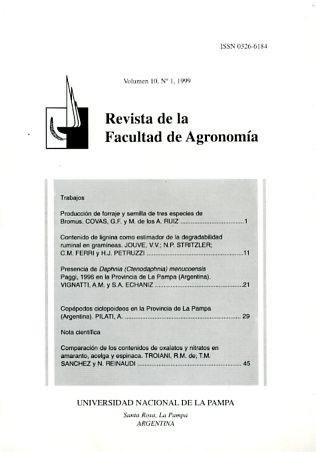Factors affecting degradation of barley straw in sacco and microbial activity in the rumen of cows fed fibre-rich diets. JI: The level of supplemental fishmeal
Palabras clave:
protein level, straw degradation, rumen, cows,Resumen
A diet composed of 76.2% untreated barley straw + 23.8% rye grass hay was given to three nonlactating cows at 90% of ad libitum intake. The cows were supplemented via cannulae with three differents levels of fishmeal in arder to make the ration up to 8%, 10% and 14% crude protein on a dry-matter basis. Treatments were arranged in a Latin Square design. Nylon bags containing untreated barley straw were incubated in the rumen 01 the cows for up to 72 h. Degradability of dry matter, total organic matter and the individual components of the cell wall of barley straw were affected by the protein level of the dlel. The Inclusion of fishmeal to a Ievel of 14% dietary protein produced the highest degradability of all parameters measured. The protein level also affected ammonia and total VFA concentrations; both fermentation products were highest in the treatment with the high fishmeal level. Rumen pH and rumen outflow rate of Iiquid and particulate phases were not affected by protein level. The ATP concentration found in the solid residue, remaining after removal of the liquid phase from the rumen content, Increases with increasing fishmeal level., while ATP in the Iiquid phase remained unchanged. This indicates that, under the conditions of this study, fishmeal exerts its effects on the microbes intimately associated lo the fibre, and not upon the whole microbial population. The microbial DNA concentration of digesta nylon bags increased during the first 24 h of incubation and then decreased until the end of incubation, indicating a process of colonization and depletion of degradable substrates.
Resúmenes de Trabajos presentados en otras publicaciones (por docentes de la UNLPam.), Publicado en Animal Feed Science Technology, 70: 11-22, 1998.
Descargas
Descargas
Publicado
Número
Sección
Licencia
La Editorial de la Universidad Nacional de La Pampa (EdUNLPam) exigirá a los/as autores/as la firma del siguiente documento:
La EdUNLPam lleva a cabo la publicación del artículo: (Título del Artículo) en SEMIÁRIDA Rev.Fac.Agron UNLPam ISSN 2362-4337 (impresa) ISSN 2408-4077 (en línea), del cual el/los abajo firmantes son autores de una o más partes. En el mismo acto, el/los autores entregan exclusivamente a la EdUNLPam todos sus derechos protegidos por las leyes de propiedad intelectual que rigen en la Argentina para reproducir, publicar, editar, fijar, comunicar y transmitir públicamente en cualquier formato o medio impreso o electrónico, inclusive internet, el artículo enviado a publicación e incluirlo en índices o bases de datos nacionales e internacionales. A cambio, la EdUNLPam entrega a los autores la autorización para la publicación o reimpresión con ines académicos y educativos en cualquier libro o medio de divulgación, con la sola obligación de citar el artículo original publicado en la EdUNLPam. Cada autor acuerda en que el material provisto a la EdUNLPam es un trabajo original, que no ha sido impreso o publicado en cualquier otro medio con anterioridad y que no vulnera derechos de terceros. El Primer autor tendrá la posibilidad de leer y corregir el artículo ya editado como “prueba de galera”, pero si el autor no devolviera esas correcciones de la prueba de galera dentro del tiempo especificado, el proceso de producción y publicación podrá proseguir sin la aprobación del autor. El/los autor/es no recibirán compensación monetaria de la EdUNLPam por el uso del material contenido en este artículo y asumen la responsabilidad de las opiniones vertidas en él.






.png)



22.png)


.jpg)




.jpg)
10.png)



